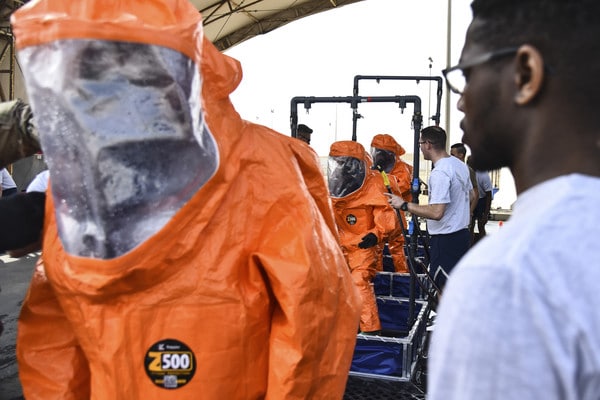This simple guide discusses how to use a hazmat suit correctly, including putting it on, removing it, cleaning / decontamination, and disposal.
A hazmat suit is a full body multipurpose protective garment that shields you from inhaling or coming into contact with hazardous chemicals, biological agents or radiation. Personnel must be specifically trained to wear hazmat suits in order to deal with hazardous materials.
If you’re considering the purchase of a hazmat suit and have questions we recommend reading our helpful Essential Hazmat Suit Buying Guide here >
Putting On a Hazmat Suit
According to the Center for Disease Control (CDC), Hazmat suits are worn on top of normal clothes or protective undergarments.
The sequence of putting on a hazmat suit is:
- Gloves
- Sleeves
- Shoes
- Hood
- Face mask
This sequence is designed to allow the wearer to properly make the hazmat suit airtight.

After donning the suit, it must be further secured and sealed at the following points: the face, ankles, wrists, neck and waist. Depending on the threat situation, such as a physician putting on a hazmat suit to protect against coronavirus, the seal level can vary.
Putting on a Hazmat Suit correctly can be time consuming even in the midst of events such as chemical spills or biological warfare. It can take up to 30 minutes to put one on properly.
Removing a Hazmat Suit
Taking a hazmat suit off should be done with utmost focus on safety.
It is essential that you don’t contaminate the clothing under the suit and most importantly, your skin.
Generally, it is best to walk through a decontamination sequence before taking a hazmat suit off. This includes walking through a series of showers, which may contain decontamination agents, soap and/or clean water. This must be contained in pools to prevent the contaminated liquid from spreading and re-contaminating your suit or body.
Once the hazmat suit has been washed off while wearing it, the best way to remove the suit safely is to roll it downward, being very careful not to touch the suit exterior. The gloves come off with the suit by pulling your hands out and turning them inside-out.
If you are wearing boots over the suit, they must be removed first before rolling the suit down.
The breathing apparatus must be removed last. You should never touch the front of the breathing apparatus when taking it off.
Your hands should also be washed between each step of removing your hazmat suit.
Hazmat Suit Cleaning and Disinfection
Hazmat suits are generally made for single use. However, if the suit is designed for multiple uses, then it must be cleaned and disinfected properly after removal.
The first step is to following the suit manufacturer’s guidelines. This is important since there might be some damage to the suit caused by using the wrong cleaning agents or techniques.
Once the suit is clean, wipe off any remaining liquid in the suit using absorbent material such as a sponge. Dry it on a rack as stipulated by the manufacturer. The best hazmat suit drying conditions are temperatures not exceeding 40 degrees celcius
The suit should be allowed at least 2 hours drying time. After the suit is dry, it should then be hung up or re-packed according to the manufacturer’s guidelines.
For more information, see our post Are Hazmat Suits Washable?
Hazmat Suit Disposal
Most hazmat suits are designed for single use, and cannot be cleaned and worn again.
According to the Federal Emergency Management Agency (FEMA), contaminated hazmat suits must be disposed of in a responsible manner so that the environment doesn’t get contaminated.
Re-usable hazmat suits may also become disposable when they have been reused for too long. Cumulative wear and tear by bleaching agents and cleaning over time may compromise the impermeability of the suit’s material. This means disposal and also time for a new hazmat suit.
How to Use a Hazmat Suit (Levels A and B)
- Meet required medical assessments for blood pressure, pulse rate, temperature and other pre-entry physical tests
- Check the suit for any quality or damage issues
- Remove any tags or tape from new suits
- Wipe anti-fogging agent on the interior of the visor
- Do not wear boots or shoes on the inside of the suit
- Place your feet and legs into the suit first
- Have an assistant help you to maintain balance while you enter the suit. Alternately, you can enter the suit while sitting down on a chair or bench.
- Put on chemical resistant steel toe boots to protect your feet
- Pull the suit legs over the top of the outer boots
- Tighten the interior suit belt if included
- Put on the SCBA breathing pack before donning the rest of the suit. Do not connect or turn on the breathing supply until the suit is fully on.
- Turn on SCBA tank air flow and check the airflow status using the regulator guages
- Put on the independent respirator piece over your face
- Put on inner gloves if needed
- Stand and pull the upper part of suit over your head and insert your hands into the gloves
- Attach the breathing air supply and begin breathing through the SCBA
- Zip up the suit on the front or back. Get assistance if required. Secure any and all storm flaps over the zipper.
- As an extra precaution, wrap the wrists, ankles, waist, neck and face mask area with high-test tape.
- Make sure your range of motion is acceptable in the suit before beginning tasks.
Hopefully this article has provided good infomation on how to use a hazmat suit correctly.
UP NEXT: How HAZMAT Suits Work
Looking for a Coronavirus hazmat suit and accessories? Click here > |
